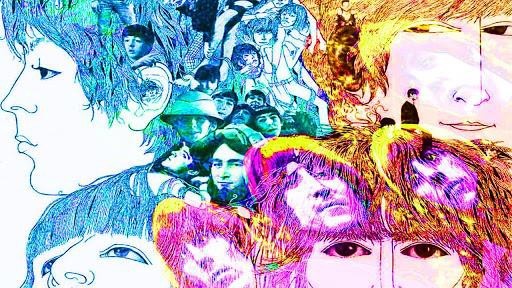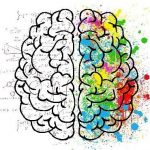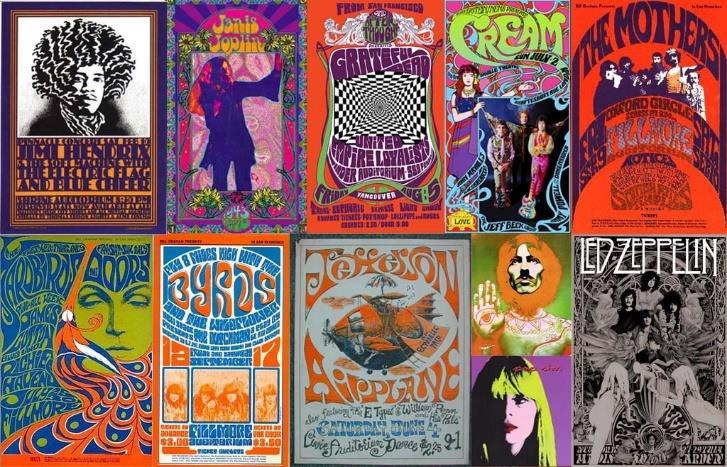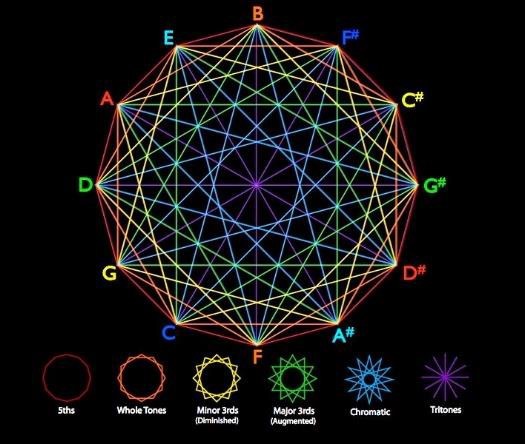
“Picture yourself in a boat on a river, with tangerine trees and marmalade skies. Somebody calls you, you answer quite slowly, a girl with kaleidoscope eyes.”
By Charlotte McAdam
Is the popular Beatles song Lucy in the Sky with Diamonds really an acronym for LSD? Or was it innocently inspired by a drawing created by John Lennon’s son? This question has exercised the minds of Beatles fans since the song first appeared in the 1967 album Sgt Pepper’s Lonely-Hearts Club Band. This magical mystery may never be solved; however, it is certain that the legendary band dabbled with psychedelic drugs throughout their career.
The Beatles are far from being the only band that make references to these substances, or consumed them to inspire their work. It is common knowledge that particular drugs are used, and of course abused, by artists around the world.
Together, let’s take a trip and explore why so many successful musicians were inspired by psychedelics. Is there a much deeper connection between our emotions, music and the therapeutic benefits of these substances? And if music itself is an act of creativity, is there more to inspired thought than we currently think?
The first stop on our journey is looking at creativity, which is a multilayered phenomenon. It can be defined as a human ability that provides artistic, organisational, and scientific innovation that moves the world forward. It is a skill that transcends traditional ways of thinking or acting to develop new and original ideas, methods or objects.
One of the cornerstones of creativity has been described as divergent thinking, which is the power to think outside the box. Music is one of the most creative activities known, as it involves the application of divergent thinking by putting the brain into a ‘state of flow’. Studying creativity can be a difficult thing to do. However, advances in technology and the birth of psychology have helped us map out the brain and consequently have a greater understanding of how it functions.
Mark Beeman, a professor of Psychology and Neuroscience at North Western University and author of the book The Eureka Factor, researches the cognitive neuroscience of insight. He explains that much of the research on the neural basis of insight has been framed by hemispheric differences, namely, that the right hemisphere contributes relatively more to insight solving, whereas the left hemisphere contributes more to analytic solving. “The world is so complex that the brain has to process it in two different ways at the same time,” Beeman says. “It needs to see the forest and the trees. The right hemisphere is what helps you see the forest.”

Beeman extended his research and found that these sudden moments of insight can be measured by combining both fMRI and EEG technology. When the brain has an ‘Aha!’ moment, it is preceded by an equally sudden burst of brain activity – a spike of gamma-wave rhythm, which is the highest electrical frequency generated by the brain. Gamma rhythm is believed to come from the binding of neurons: cells distributed across the cortex draw themselves together into a new network that is then able to enter consciousness. Where does this burst of gamma waves come from? Beeman discovered the ‘neural correlate of insight’: the anterior superior temporal gyrus (aSTG). This is a small fold of tissue, located on the surface of the right hemisphere just above the ear.
Interestingly, Beeman also demonstrated that people who score high on a standard measure of happiness solve about 25 percent more insight puzzles than people who are feeling angry. It seems positive moods allow us to relax, we focus less on the troubling world and more on these remote associations.
While it’s commonly assumed that the best way to solve problems is to relentlessly focus, this clenched state of mind inhibits the sort of creative connections that lead to breakthroughs. This is why interrupting one’s focus – perhaps with walk outside or a game of Ping Pong, commonly seen at innovative companies such as Google – can be so helpful. Alpha waves emanating from the right hemisphere are closely related with relaxing activities, which explains the concept of people have some of their best ideas during a warm shower. When our minds are at ease and alpha waves are rippling through the brain, we’re more likely to direct attention inward, toward that stream of remote associations emanating from the right hemisphere. Bob Dylan says it best, the answer is blowing in the wind.
Nevertheless, creative innovation requires more than only personal insight. Even if a person experiences a useful epiphany, that new idea is rarely the end of the creative process. More recently, research shows that the neural pathways and subsequent networks play an important role in the brain’s inclination towards creativity.
This involves the interaction of three main brain networks – executive brain network, default mode network and salience network. The ability to make connections between seemingly unrelated things is a central tenet in creative thinking. Exposure to different stimuli – such as new sounds, sights and sensations – create connections in the brain via the synapses, the points of connection, between the neurons. The more neurons, the more neural pathways and synapses, the greater the opportunity to spark new ideas and solutions.
Great innovation comes when we are not only captivated by the moment and imaginative but also motivated and compassionate to engage in the activity. Creativity requires both intelligence and imagination. We must have both an ability to learn what has come before us and have foresight and envision the way the world could be. Building on the foundations that have come before us.
Freddie Mercury is seen as the creative genius behind Queen. However, if it wasn’t for the combination of the talents of his other band members, Brian May, Roger Taylor, and John Deacon, with the addition of producers, recording technology and radio, we perhaps wouldn’t have iconic hits like Bohemian Rhapsody.
A new wave of scientific research in the past few years has shown time and again that psychedelic drugs offer extreme therapeutic potential in treating mental health issues including depression, PTSD and anxiety. These studies have also given way to new findings on their possible use for creative innovation.
It’s certainly no secret that psychedelics hold incredible potential to enhance creativity. Many highly- acclaimed artists, scientists, writers and musicians have credited these substances as playing key roles in their lives. For example, Francis Crick was reported to be using low doses of LSD when he discovered the double-
helix structure of the DNA molecule. Nobel-prize-winning chemist Kary Mullis explicitly stated that psychedelics helped him to develop the polymerase chain reaction, that allows you to replicate DNA sequences in a lab. Steve Jobs, the founder of Apple, championed the LSD experience, describing it as one of the most important experiences in his life. And you certainly don’t have to look far to find examples of art and music that are influenced by psychedelic experiences.

In June 2018, researchers at the Imperial College London published a study examining the effects of psilocybin mushrooms, DMT and LSD. The participants were tested for a range of personality traits after taking the psychedelics. At the end of the three-month period of the study, results showed that the patients displayed a significant increase in cognitive flexibility or “openness” – which, according to the researchers, is at the crux of imagination, aesthetic appreciation, non-conformity, and creativity.
Ground breaking research funded by the Beckley Foundation has revealed that psychedelics allow new, unique connections to be made by connecting areas of the brain that normally keep to themselves. It’s possible that this is the basic mechanism through which these psychoactive compounds have their effect on creativity. Cutting-edge brain imaging technology shows the increased brain connectivity after LSD (right), compared to placebo (left).
Michael Pollan, author of the book How to Change Your Mind writes about the science behind psychedelics. He explains that people who try psychedelics, experience something that is known as “ego dissolution,” which is what happens when the sense of “self” totally disappears. When people report this feeling, there is a precipitous drop-off in activity in a part of the brain called the default mode network (DMN). This network seems to play some kind of regulatory role in how the brain communicates with itself. The brain starts to form new linkages and new connections. Parts of the brain that didn’t communicate before suddenly strike up conversations. It seems that psychedelics open the pathways for the brain to more actively collaborate within itself, and quietens the DMN or the ‘inner critic’.
Marijuana seems to make insights more likely. A paper by scientists at University College London, found that not only does cannabis lead to states of relaxation, but it also increases brain activity in the right hemisphere. This explains why marijuana has so often been used as a creative fuel; it seems to make the brain better at detecting the remote associations that define the insight process.
While constant interval conversations and collaboration in the brain may birth amazing creativity and “out of the box” thought, there can, however, be too much of a good thing.
For example, Methadone in an administered and controlled situation, can be moderately safe and is regularly used today by medical professionals for pain management. From the same source the street drug Heroin is made, which can become life-threatening with a high potential of abuse.
Similarly, there needs to be protocols put in place for psychedelics to be used in not only a safe setting, but in a controlled way to reap the most from their creative benefits. The purpose of going down the proverbial “rabbit hole”, is to bring something back with you.
This notion is best summed up in the words of Alan Watts “If you get the message, hang up the phone. For psychedelic drugs are simply instruments, like microscopes, telescopes, and telephones. The biologist does not sit with eye permanently glued to the microscope, he goes away and works on what he has seen.”
A person can’t live in a constant state of having these light bulb moments any more than a top athlete can maintain peak performance over extended periods of time. Psychedelics however, could be a switch to help turn the creative mind on and off again. Already we are seeing the start of positive steps in this direction, with micro-dosing growing in study and usage in Silicon Valley in the USA. Since creativity lies at the heart of solving the problems we face as a species, it is an essential part of moving humanity forward. Psychedelics could just be that missing link.
Like any good journey, there are many factors that play into a person having a positive trip. Set and setting, are the most important aspects in the psychedelic experience. A person’s mindset “set” and the physical and social environment “setting” in which the user has the experience can greatly influence the outcome.

The drug itself does not produce the transcendent experience; it acts as the chemical key to open the mind. Which is where music comes into play.
The story of psychedelics is intertwined with the story of music, and tracing their relationship can feel like going in circles. It’s well known that rock musicians have always been heavily influenced by psychoactive compounds, inspiring an entire genre known as ‘Psychedelia’.
From Sting, the lead singer of The Police who wrote various hits after his experiences with Peyote and Ayahuasca to Green Day, who’s lead singer Billie Joe named the band after his first pot experience. From the band The Doors, who got their name from the Aldous Huxley book titled The Doors of Perception (which is based on the writer’s psychedelic experience under the influence of Mescaline) to Pink Floyd, Jimi Hendrix, Elton John, Eric Clapton, The Beach Boys, The Rolling Stones, Led Zeppelin and The Grateful Dead. The list is as endless and timeless as the music itself. Interestingly, they also all explore similar themes of love, universal connection and peace.
The echoes of the psychedelic musical revolution are still seen today, influencing a whole new generation of musicians. Artists including Chance the Rapper, A$AP Rocky, Post Malone, Harry Styles, Noah Cyrus and Kacey Musgraves have all spoken about their experiences and how their music has been inspired from their trip.
We all know a particular song that can transport our minds to the moment we first heard that piece. Perhaps we remember the people we were with or the emotions we were feeling at that time. But the way we react to instrumental music, orchestras and symphonies, also allow us to connect to emotions and have vivid memories of times not linked to that song. It is almost as though music is so embedded into our nature, that it allows us access to deeper parts of our subconscious.

To understand this concept, we need to travel back in time to around 550 BC. Pythagoras, the Greek philosopher, is attributed with discovering that a string exactly half the length of another will play a pitch that is exactly an octave higher when struck or plucked. One of his most important discoveries was that harmonic musical intervals could be expressed by perfect numerical ratios, a finding that led him to the realisation that all sensible phenomena follow the pattern of number. Therefore, the current music scale that we use is credited to Pythagoras.
He is also responsible for a theory known as The Harmony of the Sphere’s. Pythagoras proposed that the Sun, Moon and planets all emit their own unique hum based on their orbital revolution, and that the quality of life on Earth reflects the tenor of celestial sounds, which are physically imperceptible to the human ear.
Pythagoras believed music was medicine, and could heal diseases in the body. He used various intervals of harmonic ratios to “align souls to their divine nature”. The philosopher taught that music should never be approached merely as a form of entertainment. Rather, he proposed that music was an expression of “Harmonia”, the divine principle that brings order to chaos and discord. Music, just like mathematics, has a dual value because it enables humans to see into the structures of nature.
Music has evolved exponentially since that time, with its origins unknown, it is an integral part of human history. Music is found in every known society, past and present, including the most isolated tribal groups.
It seems music and the mind have always been closely connected. From the drums that motivate men to action or the calming sounds of a mother singing her child to sleep. What we can see from our history is that music has always been a part of uplifting or easing our emotions. Just like the stars gravitational orbit, music appears to bring order to the chaos of our minds.
Several studies published in ‘PLOS ONE’, have found positive changes that happen in the brain when people listen to music. One study found that listening to “happy” music – defined as classical tunes that were upbeat and stimulating – helped people perform better on tasks that involved “divergent” thinking.
Another, found that people who listened to classical music were more willing to share personal information about themselves in writing. Catherine Jackson, a licensed clinical psychologist based in Chicago, noticed a similar effect during neurotherapy sessions when she played classical music while patients engaged in deep breathing. Jackson says “Some patients who typically have a hard time sharing or discussing emotional content are better able to open up and share,” adding that music may help relax people enough to open up about painful issues. Music can be an important component for healing during a psychology session, and studies have shown that it’s a pivotal part of psychedelic-psychotherapy.
Around the 1960s, scientists began studying the relationship between psychedelics and music. The scientists found that what LSD does to your brain seems to be similar to jazz improvisation “Just like these musicians use many more musical notes in a spontaneous and non-random fashion, your brain combines many more of the harmonic waves (connectome harmonics) spontaneously yet in a structured way.”
Much of the music used within this type of therapy is not especially “trippy.” Rather, it’s is there to evoke and support emotional experiences, including emotionally intense memories, thoughts or experiences. Most of the music used in psychedelic-assisted sessions is instrumental, and if there are vocals present, they are in an unfamiliar language. This is to make sure that the music is not conveying a specific meaning or telling a specific story.
This is similar to how indigenous tribes use singing, chanting and drumming during ceremonial use of psychedelic plants. The shamans of the amazon region believe the most important tool used during Ayahuasca ceremonies is the ‘icaro’. These traditional songs sung or whistled by shamans positively influence the internal landscape of a person’s psyche. Shamans believe drinking the ayahuasca brew puts you in direct contact with the spiritual plane, opening you up to both beneficent and bad spirits. Ultimately, the purpose of the icaro is guidance.
Iboga ceremonies in Africa, are another example of where music is used to facilitate subjective effects of the hallucinogenic substance. Participants who digest the iboga root, are subjected to polyrhythmic drumming by the shamans to induce a powerful trance. Researchers who have observed this practice of spirit mediumship have been informed that music acts as a safety-rope between this world and ‘the hereafter’. The increase in rhythmic changes, which stimulates the cerebellum and hippocampus in the same way as the plant, is assumed to augment the effect of the psychedelic substance. Researchers suggest that music and sound construct the place which is visited during the experience.

Since psychedelic treatment can assist in a wide variety of mental illness, and sound therapy can do the same, can the combination of the two be one of the most powerful tools humans have to change the connections in the individual’s brain?
Tania De Jong, founder of Creativity Australia and co-founder of Mind Medicine Australia, explores the topics of creativity, music and neuroscience in her celebrated TEDx Melbourne Talk. Tania explains “the neuroscience of singing, shows that when we sing our neurotransmitters connect in new and different ways”. She continues by stating that research shows that music, like psychedelics, fire up the right frontal lobe, releasing endorphins that make us smarter, healthier, happier and more creative.
Tania additionally quotes an interesting study from the Sahlgrenska Academy at the University of Gothenburg in Sweden, which measured the heart rates of choir members. The researchers found that when a group sings together long enough, everyone’s hearts start beating as one, in a unified rhythmic pattern.
This activity creates physical changes in the body including lowering the stress hormone cortisol in the blood stream to toning our intercostal muscle, improving oxygen levels to the brain and boosting our immune system. The Swedish study goes on to say “singers may change their egocentric perspective of the world to a we-perspective – this touches on the fundamental question of why music is a universal phenomenon. If collective singing creates joint perspectives, it would indeed be bonding in the deepest sense.”
This research accurately emphasises the importance of set and setting during a psychedelic experience. Music is an essential component for these substances to be beneficial in the healing process. Music is a key element as it helps connect personal themes and emotions. Psychedelics and music work together, like a beautiful symphony.
Creativity, psychedelics and music is a relationship that seems to be connected in a never-ending cycle. Harmoniously working alongside each other to assist in fine tuning wiring in the brain. Whether that’s through providing creative solutions or provoking intensely meaningful experiences. Psychedelics help open the mind, while music acts as a sort of mental tour guide, to lead you to your destination, wherever that might be.
10 WONDROUS THINGS THAT HAPPEN TO YOUR BODY WHEN YOU LISTEN TO CLASSICAL MUSIC
The Healthy. 2020. 10 Wondrous Things That Happen to Your Body When You Listen to Classical Music. [online] https://www.thehealthy.com/mental- health/classical-music-effects/
CAN PSYCHEDELIC DRUGS ENHANCE CREATIVITY?
MAPS. 2020. Can Psychedelic Drugs Enhance Creativity? – MAPS. [online] https://maps.org/news/multimedia-library/3171-can-psychedelic-drugs-enhance-creativity
HOW SINGING TOGETHER CHANGES THE BRAIN
DE JONG, T. 2013. How singing together changes the brain: Tania De Jong AM at TEDX Melbourne. [online] https://www.youtube.com/watch?v=I_HOBr8H9EM
HOW TO CHANGE YOUR MIND: THE NEW SCIENCE OF PSYCHEDELICS
POLLAN, M., 2019. How to Change Your Mind. [United States]: NIELSEN BOOKDATA. IMAGINE: THE SCIENCE OF CREATIVITY
Lehrer, J., 2012. Imagine. [Grand Haven, Ml]: Brilliance Audio.
LSD TREATMENTS CAN ACTUALLY ‘HARMONISE’ THE BRAIN, STUDY SHOWS
McRae, M., 2020. LSD Treatments Can Actually ‘Harmonise’ The Brain, Study Shows. [online] ScienceAlert. https://www.sciencealert.com/lsd-psychedelic-therapeutic-treatment-mental-illness-resets-brain-network-harmonics
OUT OF THE BOX: A PSYCHEDELIC MODEL TO STUDY THE CREATIVE MIND
Kuypers, K., 2018. Out of the box: A psychedelic model to study the creative mind. Medical Hypotheses, 115, pp.13-16. PYTHAGORAS AND THE CONNECTION BETWEEN MUSIC AND MATH
Stewart, J., 2020. Timeline 002: Pythagoras And the Connection Between Music and Math. [online] Vpr.org. https://www.vpr.org/post/timeline-002-pythagoras-and-connection-between-music-and-math#stream/0
THE SCIENCE OF LSD IN THE BRAIN
The Beckley Foundation. 2020. The Science of LSD In the Brain [online] https://www.beckleyfoundation.org/the-brain-on-lsd-revealed-first-scans-show-how-the-drug-affects-the-brain/
THE SPIRITUAL AND THERAPUTIC BENEFITS OF ICAROS SONGS IN AN AYAHUASCA CEREMONY
Staff, P. and Staff, P., 2020. The Spiritual and Therapeutic Benefits of Icaros Songs in An Ayahuasca Ceremony. [online] Psychedelic Times. https://psychedelictimes.com/the-spiritual-and-therapeutic-benefits-of-icaros-songs-in-an-ayahuasca-ceremony/
WHY PSYCHEDELIC DRUGS COULD TRANSFORM HOW WE TREAT DEPRESSION AND MENTAL ILLNESS
Vox. 2020. Why Psychedelic Drugs Could Transform How We Treat Depression and Mental Illness. [online] https://www.vox.com/science-and-health/2018/5/21/17339488/psychedelics-mental-health-michael-pollan-lsd-psilocybin